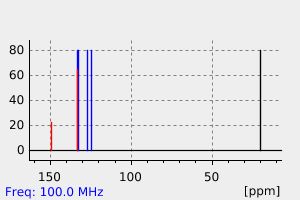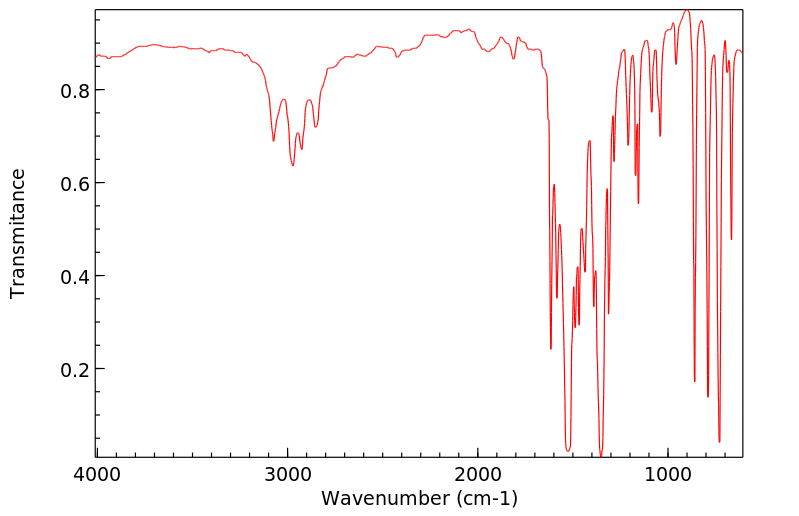甲基硝基苯 | 88-72-2
-
物化性质
-
计算性质
-
ADMET
-
安全信息
-
SDS
-
制备方法与用途
-
上下游信息
-
文献信息
-
表征谱图
-
同类化合物
-
相关功能分类
-
相关结构分类
物化性质
-
熔点:-9 °C
-
沸点:225 °C(lit.)
-
密度:1.163 g/mL at 25 °C(lit.)
-
蒸气密度:4.72
-
闪点:223 °F
-
溶解度:0.65克/升(实验值)
-
介电常数:27.399999999999999
-
暴露限值:NIOSH REL: TWA 2 ppm (11 mg/m3), IDLH 200 ppm; OSHA PEL: TWA 5 ppm (30 mg/m3); ACGIH TLV: TWA 2 ppm (adopted).
-
物理描述:Yellow liquid with a weak, aromatic odor. [Note: A solid below 25°F.]
-
颜色/状态:Yellowish liquid at ordinary temperature
-
气味:Weak, aromatic odor
-
蒸汽密度:4.72 (NTP, 1992) (Relative to Air)
-
蒸汽压力:0.185 mm Hg at 25 °C
-
亨利常数:1.25e-05 atm-m3/mole
-
大气OH速率常数:7.00e-13 cm3/molecule*sec
-
稳定性/保质期:
/Heat contributes/ ... to instability. /Nitrotoluene/
-
自燃温度:Auto-ignition temperature: 420 °C
-
分解:The substance decomposes ... /to/ form nitrogen oxides, carbon monoxide.
-
粘度:2.7 mPa (= cP)
-
燃烧热:-11,290 Btu/lb = -6,272 cal/g = -262 x 10+5 J/kg
-
汽化热:12,239.1 gcal/gmole
-
表面张力:In dynes/cm: 42.29, 41.76, and 40.50 at 15, 19.5, 20, and 30 °C, respectively
-
电离电位:9.43 eV
-
气味阈值:0.05 mg/l
-
折光率:Index of refraction: 1.5472 at 20 °C/D
-
保留指数:1155;1153.4
计算性质
-
辛醇/水分配系数(LogP):2.3
-
重原子数:10
-
可旋转键数:0
-
环数:1.0
-
sp3杂化的碳原子比例:0.142
-
拓扑面积:45.8
-
氢给体数:0
-
氢受体数:2
ADMET
安全信息
-
职业暴露等级:A
-
职业暴露限值:TWA: 2 ppm (11 mg/m3) [skin]
-
TSCA:Yes
-
危险等级:6.1
-
立即威胁生命和健康浓度:200 ppm
-
危险品标志:T,N
-
安全说明:S16,S27,S45,S53,S61
-
危险类别码:R22,R45,R51/53,R62,R46
-
WGK Germany:3
-
海关编码:29042000
-
危险品运输编号:UN 1664 6.1/PG 2
-
危险类别:6.1
-
RTECS号:XT3150000
-
包装等级:II
SDS
制备方法与用途
**邻硝基甲苯**又称2-硝基甲苯或1-甲基-2-硝基苯。这是一种黄色的油状透明液体,具有类似硝基苯的独特气味,相对密度为1.1629。其熔点在α型(稳定型)时为-2.9℃、β型(非稳定型)时为-9.5℃;沸点分别为221.7℃、118℃(压力为2.133×10³Pa)、50.0℃(压力为0.133×10³Pa)。闭杯闪点为106.1℃。折射率为1.5450,黏度在15℃时为0.0262mPa·s。蒸汽压在不同温度下的数值分别为:5℃时10.906×10³Pa、10℃时12.639×10³Pa、20℃时14.612×10³Pa和30℃时15.892×10³Pa。它微溶于水(在30℃下溶解度为0.061),易溶于苯、氯仿及石油醚,能与乙醇和乙醚混溶,并随水蒸气一起挥发。
由于硝基的强吸电子性,使甲基易于被氧化成邻硝基苯甲醛或邻硝基苯甲酸;在催化剂作用下还原,则生成邻甲苯胺。进一步硝化后可以产生2,4-二硝基甲苯或2,6-二硝基甲苯;也可以氯化生成硝基苄氯,或者形成偶氮化合物。
大鼠经口摄入半数致死量(LD50)为801mg/kg。
主要用途
邻硝基甲苯广泛用于合成染料原料如4-氯-2-硝基甲苯、6-氯-2-硝基甲苯、邻甲苯胺和联邻甲苯胺等中间体。其中,4-氯-2-硝基甲苯可作为医药原料;而邻甲苯胺则用于农药杀菌剂及香料制造的原料;它也参与了2,2′-二硝基苄、邻硝基苄基溴以及溴己烷等医药中间体的制备过程。此外,邻硝基甲苯还能用于制备吲哚作为氨基酸和植物生长调节剂的来源,并且是二硝基甲苯(用作火药)的重要成分;邻甲苯胺还可用作硫化促进剂。
化学性质
黄色易燃液体,不溶于水,但可溶解在氯仿和苯中。与乙醇、乙醚混合后可相互溶解。
用途
主要用于生产邻甲苯胺、联甲苯胺等,并且是染料、涂料、塑料及医药产业不可或缺的重要原料。在药物制造领域,它可以用来合成硝苯吡啶、痛惊宁、丙咪嗪盐酸盐、溴已胺盐酸盐以及双氯苯唑青霉素钠。
生产方法
通过将甲苯与混酸(由25-30%硝酸和55-58%硫酸以及20-21%水组成)反应生成邻硝基甲苯。反应温度一般控制在40-45℃之间,以提高产物纯度。随后进行蒸馏分离,从而获得高纯度的邻位及对位硝基甲苯(纯度分别可达98%和99%)。工艺过程中,需消耗一定量的原料:甲苯(98%浓度)约0.8吨/吨、硝酸(98%浓度)约0.47吨/吨、硫酸(92.5%浓度)约0.45吨/吨和烧碱(42%浓度)100kg/t。
急性毒性
- 大鼠口服LD50: 891毫克/公斤
- 小鼠口服LD50:970毫克/公斤
危险特性
与空气混合可爆炸;遇热可能发生爆炸。 易燃,燃烧时会产生有毒氮氧化物烟雾。
储存运输要求
需储存在低温干燥的仓库中,并应将该物质与氧化剂和食品添加剂分开存放。
灭火方法
上下游信息
-
上游原料
中文名称 英文名称 CAS号 化学式 分子量 3-甲基-4-硝基苯胺 4-nitro-3-methylaniline 611-05-2 C7H8N2O2 152.153 2-硝基苄氯 2-nitrobenzyl chloride 612-23-7 C7H6ClNO2 171.583 硝基乙苯 2-nitro(ethylbenzene) 612-22-6 C8H9NO2 151.165 2-硝基苄溴 2-nitrophenylmethyl bromide 3958-60-9 C7H6BrNO2 216.034 4-甲基-3-硝基苯胺 4-Methyl-3-nitroanilin 119-32-4 C7H8N2O2 152.153 2-甲基-3-硝基苯胺 3-nitro-o-tolylamine 603-83-8 C7H8N2O2 152.153 2,4-二硝基甲苯 2,4-DNt 121-14-2 C7H6N2O4 182.136 厄多司坦 2-nitrosotoluene 611-23-4 C7H7NO 121.139 2-(2-硝基苯基)乙醇 2-nitro-benzeneethanol 15121-84-3 C8H9NO3 167.164 —— 2-nitro-benzaldehyde hydrazone 3718-21-6 C7H7N3O2 165.151 2-(2-硝基苯基)乙醛 (2-nitrophenyl)acetaldehyde 1969-73-9 C8H7NO3 165.148 2-溴-6-硝基甲苯 2-bromo-6-nitrotoluene 55289-35-5 C7H6BrNO2 216.034 2-碘-6-硝基甲苯 2-iodo-6-nitrotoluene 41252-98-6 C7H6INO2 263.035 —— trimethyl(2-nitrobenzyl)silane 17876-76-5 C10H15NO2Si 209.32 —— 2-nitrocinnamic acid 612-41-9 C9H7NO4 193.159 2-硝基苯乙酸 2-(2-nitrophenyl)acetic acid 3740-52-1 C8H7NO4 181.148 3-(2-硝基苯基)丙酸 3-(2-nitrophenyl)propionic acid 2001-32-3 C9H9NO4 195.175 硝基苯 nitrobenzene 98-95-3 C6H5NO2 123.111 二硝基甲苯 1-methyl-2,3-dinitrobenzene 602-01-7 C7H6N2O4 182.136 4-甲基-3-硝基苯甲酸 4-methyl-3-nitrobenzoic acid 96-98-0 C8H7NO4 181.148 —— o-nitrobenzylphosphonic acid 13318-66-6 C7H8NO5P 217.118 - 1
- 2
- 3
-
下游产品
中文名称 英文名称 CAS号 化学式 分子量 —— 1-(fluoromethyl)-2-nitrobenzene —— C7H6FNO2 155.129 2-硝基苄氯 2-nitrobenzyl chloride 612-23-7 C7H6ClNO2 171.583 1-(2-硝基苯基)甲胺 2-nitrobenzylamine 1904-78-5 C7H8N2O2 152.153 1-(碘甲基)-2-硝基苯 2-nitrobenzyl iodide 29872-21-7 C7H6INO2 263.035 2-硝基苯乙烯 2-nitrostyrene 579-71-5 C8H7NO2 149.149 2-硝基苯甲腈 o-nitrobenzonitrile 612-24-8 C7H4N2O2 148.121 2-硝基苄溴 2-nitrophenylmethyl bromide 3958-60-9 C7H6BrNO2 216.034 邻硝基苯甲醇 2-Nitrobenzyl alcohol 612-25-9 C7H7NO3 153.137 邻硝基苯甲醛 2-nitro-benzaldehyde 552-89-6 C7H5NO3 151.122 2,5-二硝基甲苯 2,5-dinitrotoluene 619-15-8 C7H6N2O4 182.136 3-硝基邻二甲苯 2,3-dimethylnitrobenzene 83-41-0 C8H9NO2 151.165 2,6-二硝基甲苯 2,6-Dnt 606-20-2 C7H6N2O4 182.136 4-氯-2-硝基甲苯 4-chloro-2-nitrotoluene 89-59-8 C7H6ClNO2 171.583 2,4-二氨基-6-硝基甲苯 2,4-diamino-6-dinitrotoluene 6629-29-4 C7H9N3O2 167.167 3-甲基-4-硝基苯甲胺 1-(3-methyl-4-nitrobenzyl)methanamine 229633-56-1 C8H10N2O2 166.18 4-碘-2-硝基甲苯 4-iodo-2-nitrotoluene 41252-97-5 C7H6INO2 263.035 4-溴-2-硝基甲苯 4-bromo-2-nitrotoluene 60956-26-5 C7H6BrNO2 216.034 N-羟基-2-甲苯胺 N-(o-tolyl)hydroxylamine 611-22-3 C7H9NO 123.155 syn-2-硝基苯甲醛肟[脱保护剂] (E)-2-nitrobenzaldehyde oxime 4836-00-4 C7H6N2O3 166.136 邻硝基苯乙腈 2-nitro-benzeneacetonitrile 610-66-2 C8H6N2O2 162.148 2,4-二硝基甲苯 2,4-DNt 121-14-2 C7H6N2O4 182.136 厄多司坦 2-nitrosotoluene 611-23-4 C7H7NO 121.139 2-(2-硝基苯基)乙醇 2-nitro-benzeneethanol 15121-84-3 C8H9NO3 167.164 1-二氯甲基-2-硝基苯 o-nitrobenzal chloride 3284-77-3 C7H5Cl2NO2 206.028 1-(甲氧基甲基)-2-硝基苯 1-(methoxymethyl)-2-nitrobenzene 38177-30-9 C8H9NO3 167.164 1-(2-氯乙基)-2-硝基苯 2-(2-nitrophenyl)ethyl chloride 28917-41-1 C8H8ClNO2 185.61 N-甲基-2-硝基苄胺 (2-nitrobenzyl)methylamine 56222-08-3 C8H10N2O2 166.18 3-硝基邻二溴甲苯 o-nitro-α,α-dibromomethylbenzene 65962-15-4 C7H5Br2NO2 294.93 2-(2-硝基苯基)乙醛 (2-nitrophenyl)acetaldehyde 1969-73-9 C8H7NO3 165.148 4-氨基-2,6-二硝基甲苯 4-Amino-2,6-dinitrotoluene 19406-51-0 C7H7N3O4 197.15 3-硝基-4-甲基苄氯 4-methyl-3-nitrobenzyl chloride 84540-59-0 C8H8ClNO2 185.61 4-甲基-3-硝基苄胺 4-methyl-3-nitro-benzylamine 623155-53-3 C8H10N2O2 166.18 2-氯-6-硝基甲苯 6-chloro-2-nitrotoluene 83-42-1 C7H6ClNO2 171.583 2-溴-6-硝基甲苯 2-bromo-6-nitrotoluene 55289-35-5 C7H6BrNO2 216.034 2-碘-6-硝基甲苯 2-iodo-6-nitrotoluene 41252-98-6 C7H6INO2 263.035 2-氟-6-硝基甲苯 1-fluoro-2-methyl-3-nitrobenzene 769-10-8 C7H6FNO2 155.129 —— nitrobenzotrichloride 10542-55-9 C7H4Cl3NO2 240.473 —— 2-nitrobenzyl thiocyanate 85071-27-8 C8H6N2O2S 194.214 —— 2-nitrodiphenylmethane 5840-40-4 C13H11NO2 213.236 2,4,6-三硝基甲苯 2,4,6-Trinitrotoluene 118-96-7 C7H5N3O6 227.133 2,2'-二硝基联苄 2,2'-dinitrobibenzyl 16968-19-7 C14H12N2O4 272.26 1-(3'-丁烯基)-2-硝基苯 1-(3'-butenyl)-2-nitrobenzene 102330-20-1 C10H11NO2 177.203 —— 2-ethoxymethyl-1-nitrobenzene 66424-93-9 C9H11NO3 181.191 —— 2,2'-Dinitrostilben 6275-02-1 C14H10N2O4 270.244 1-碘-3-甲基-2-硝基苯 3-iodo-2-nitrotoluene 52414-99-0 C7H6INO2 263.035 —— 2,2'-dinitrostilbene 42467-40-3 C14H10N2O4 270.244 3-溴-2-硝基甲苯 1-bromo-3-methyl-2-nitro-benzene 52414-97-8 C7H6BrNO2 216.034 —— N,N-dimethyl o-nitrostyrene amine 20973-67-5 C10H12N2O2 192.217 —— trans-β-dimethylamino-2-nitrostyrene 32991-03-0 C10H12N2O2 192.217 2-硝基对甲基异丙基苯 2-nitro-p-cymene 943-15-7 C10H13NO2 179.219 4-(2-硝基苯基)-n-丁腈 4-(2-nitrophenyl)-n-butyronitril 90915-20-1 C10H10N2O2 190.202 3-甲基-4-硝基联苯 3-methyl-4-nitrobiphenyl 69314-47-2 C13H11NO2 213.236 1-硝基-2-(硝基甲基)苯 1-nitro-2-(nitromethyl)benzene 1818-22-0 C7H6N2O4 182.136 —— trans-β-cyclopropyl-2-nitrostyrene —— C11H11NO2 189.214 —— 2-nitrophenethyl chloroformate 179691-21-5 C9H8ClNO4 229.62 —— N-(2-nitrobenzyl)aniline 33331-19-0 C13H12N2O2 228.25 4,6-二碘-2-硝基甲苯 4,6-diiodo-2-nitrotoluene 10388-22-4 C7H5I2NO2 388.931 2-硝基苯乙酸 2-(2-nitrophenyl)acetic acid 3740-52-1 C8H7NO4 181.148 1-(2-硝基苯基)乙醇 1-(2-nitrophenyl)ethan-1-ol 3205-25-2 C8H9NO3 167.164 1-(2,2-二甲氧基乙基)-2-硝基苯 1-(2,2-dimethoxyethyl)-2-nitrobenzene 79844-33-0 C10H13NO4 211.218 —— 4-nitro-3-methylacetophenone 96784-58-6 C9H9NO3 179.175 (2-硝基苯基)甲基乙酸酯 acetic acid 2-nitro-benzyl ester 77376-01-3 C9H9NO4 195.175 2-硝基苯甲酰氯 2-Nitrobenzoyl chloride 610-14-0 C7H4ClNO3 185.567 邻硝基苯甲酸 ortho-nitrobenzoic acid 552-16-9 C7H5NO4 167.121 —— (2-nitrophenyl)acetone 1969-72-8 C9H9NO3 179.175 —— (2-nitro-benzylsulfanyl)-acetic acid 1137-55-9 C9H9NO4S 227.241 —— 2-nitrosobenzyl alcohol 173548-01-1 C7H7NO2 137.138 硝基苯 nitrobenzene 98-95-3 C6H5NO2 123.111 —— 2-(2-nitrophenyl)-1,3-propanediol 15121-85-4 C9H11NO4 197.191 二硝基甲苯 1-methyl-2,3-dinitrobenzene 602-01-7 C7H6N2O4 182.136 1-甲基-2-硝基-4-[(4-硝基苯基)甲基]苯 (4-methyl-3-nitro-phenyl)-(4-nitro-phenyl)-methane 75790-82-8 C14H12N2O4 272.26 —— methyl 2-(3-methyl-4-nitrophenyl)acetate —— C10H11NO4 209.202 1-甲基-4-(4-甲基-3-硝基苯基)-2-硝基苯 3,3’-dinitroditoluene 28442-37-7 C14H12N2O4 272.26 4-(2-硝基苯基)丁酸甲酯 methyl 4-(o-nitrophenyl)butyrate 22824-20-0 C11H13NO4 223.229 —— methyl N-(2-nitrobenzyl)glycinate 179686-64-7 C10H12N2O4 224.216 1-[(2-硝基苯基)甲基]吡咯 1-(2-nitrobenzyl)-1H-pyrrole 81729-45-5 C11H10N2O2 202.213 —— 2-(2-nitrophenyl)ethylsulfonyl chloride 3192-07-2 C8H8ClNO4S 249.675 —— 4'-fluoro-3-methyl-4-nitrobiphenyl 1303573-37-6 C13H10FNO2 231.226 —— 4-(2-nitro-phenyl)-but-2-enoic acid ethyl ester 332048-07-4 C12H13NO4 235.24 1-[2-(2-硝基苯基)乙烯基]吡咯烷 (E)-1-[2-(2-nitrophenyl)ethenyl]-pyrrolidine 32989-69-8 C12H14N2O2 218.255 1-(2-硝基苄基)吡咯烷 1-(2-nitro-benzyl)-pyrrolidine 55581-63-0 C11H14N2O2 206.244 - 1
- 2
- 3
- 4
- 5
- 6
- 7
- 8
- 9
反应信息
-
作为反应物:描述:甲基硝基苯 在 苄基三甲基氯化铵 、 1,8-二氮杂双环[5.4.0]十一碳-7-烯 、 sodium hydroxide 、 三氯氧磷 作用下, 以 乙醚 、 水 、 N,N-二甲基甲酰胺 为溶剂, 反应 62.0h, 生成 1-甲氧基-1H-吲哚-3-甲醛参考文献:名称:铜催化C-S键偶联反应合成硫代吲哚的方法摘要:我们在此报道了铜催化吲哚与N-硫代琥珀酰亚胺的C-S键偶联反应,产生中等至优异的单磺酰化和双磺酰化化合物,如芳硫基吲哚、烷硫基吲哚、硒化吲哚和半胱氨酸取代的吲哚。板蓝根中吲哚生物碱C2位的硫代芳基化和硫代糖基化是通过结构修饰实现的。靛蓝靛甙III和IV的首次全合成已成功进行。原位产生的亲电子次磺基溴在催化循环中发挥重要作用。DOI:10.1021/acs.joc.3c02008
-
作为产物:描述:参考文献:名称:Jaenisch, Chemische Berichte, 1923, vol. 56, p. 2450摘要:DOI:
-
作为试剂:描述:参考文献:名称:Jacini, Gazzetta Chimica Italiana, 1941, vol. 71, p. 53,57摘要:DOI:
文献信息
-
Npy antagonists, preparation and uses申请人:Botez Iuliana公开号:US20090233910A1公开(公告)日:2009-09-17The present invention concerns novel compounds, their preparation and their uses, therapeutic uses in particular. More specifically it concerns derivative compounds having at least two aromatic cycles, their preparation and their uses, in particular in the area of human or animal health. These compounds have an affinity for the biological receptors of neuropeptide Y, NPY, present in the central and peripheral nervous systems. The compounds of the invention are preferably NPY antagonists, and more particularly antagonists of sub-type NPY Y1, and can therefore be used for the therapeutic or prophylactic treatment of any disorder involving NPY. The present invention also concerns pharmaceutical compositions containing said compounds, their preparation and their uses, as well as treatment methods using said compounds.本发明涉及新颖化合物,它们的制备和用途,特别是在治疗方面的用途。更具体地说,它涉及至少具有两个芳香环的衍生化合物,它们的制备和用途,特别是在人类或动物健康领域。这些化合物对存在于中枢和外周神经系统中的神经肽Y(NPY)的生物受体具有亲和力。本发明的化合物优选为NPY拮抗剂,更具体地说是NPY Y1亚型的拮抗剂,因此可用于治疗或预防涉及NPY的任何疾病。本发明还涉及含有所述化合物的药物组合物,其制备和用途,以及使用所述化合物的治疗方法。
-
Synthesis and Biological Activity of Novel Phenyltriazolinone Derivatives作者:Qiongyou Wu、Guodong Wang、Shaowei Huang、Long Lin、Guangfu YangDOI:10.3390/molecules15129024日期:——Phenyltriazolinones are one of the most important classes of herbicides targeting the protoporphyrinogen oxidase enzyme. A series of triazolinone derivatives containing a strobilurin pharmacophore were designed and synthesized with the aim of discovering new phenyltriazolinone analogues with high activity. The herbicidal activity of the synthesized compounds was assayed and some of the test compounds displayed moderate herbicidal activity at 150 g ai/ha.
-
Method For Decarboxylating C-C Cross-Linking Of Carboxylic Acids With Carbon Electrophiles申请人:Goossen Lukas公开号:US20080177114A1公开(公告)日:2008-07-24The invention relates to a method for decarboxylating C—C bond formation by reacting carboxylic salts with carbon electrophiles in the presence of transition metal compounds as catalysts. The method represents a decarboxylating C—C bond formation of carboxylic acid salts with carbon electrophiles, wherein the catalyst contains two transition metals and/or transition metal compounds, from which one is present, preferably, in the oxidation step, which are different from each other by one unit, and catalyzes a radical decarboxylation which is absorbed during the second oxidation steps, which are different from each other by two units and catalyzes the two electron processes of a C—C bond formation reaction.
-
Copper-Based Intermetallic Electride Catalyst for Chemoselective Hydrogenation Reactions作者:Tian-Nan Ye、Yangfan Lu、Jiang Li、Takuya Nakao、Hongsheng Yang、Tomofumi Tada、Masaaki Kitano、Hideo HosonoDOI:10.1021/jacs.7b08252日期:2017.11.29The development of transition metal intermetallic compounds, in which active sites are incorporated in lattice frameworks, has great potential for modulating the local structure and the electronic properties of active sites, and enhancing the catalytic activity and stability. Here we report that a new copper-based intermetallic electride catalyst, LaCu0.67Si1.33, in which Cu sites activated by anionic过渡金属间化合物的开发,其中活性位点并入晶格骨架中,具有很大的潜力来调节活性位点的局部结构和电子性质,并增强催化活性和稳定性。在这里,我们报道了一种新型的铜基金属间电催化剂LaCu 0.67 Si 1.33,其中具有低功函的阴离子电子激活的Cu位原子原子地分散在晶格骨架中,并提供硝基芳烃的选择性加氢,其营业额高40倍以上频率(TOF高达5084 h –1),而不是经过深入研究的金属负载催化剂。利用同位素效应的动力学分析表明,氢键的裂解是决定速率的步骤。出乎意料的是,LaCu 0.67 Si 1.33的高载流子密度和低逸出功(LWF)特性使得能够以极低的活化能(E a = 14.8 kJ·mol –1)活化氢分子。此外,LaCu 0.67 Si 1.33的高氧亲合力可实现通过硝基优先吸附硝基芳烃表面,导致高化学选择性。本发明的有效催化剂可以进一步引发具有高活性的其他含氧官能团例如醛和酮的氢化
-
Palladium nanoparticles stabilized by aqueous vesicles self-assembled from a PEGylated surfactant ionic liquid for the chemoselective reduction of nitroarenes作者:Zhu-bing Xu、Guo-ping Lu、Chun CaiDOI:10.1016/j.catcom.2017.04.051日期:2017.8can be applied for stabilizing palladium nanoparticles, which prove to be an efficient catalytic system for chemoselective hydrogen transfer of nitroarenes using hydrazine hydrate as a hydrogen source. The particle sizes of vesicles are decreased with the increase of ionic liquid's concentrations and relatively small particle sizes are beneficial to the reduction. Moreover, the aqueous catalytic system
表征谱图
-
氢谱1HNMR
-
质谱MS
-
碳谱13CNMR
-
红外IR
-
拉曼Raman
-
峰位数据
-
峰位匹配
-
表征信息









